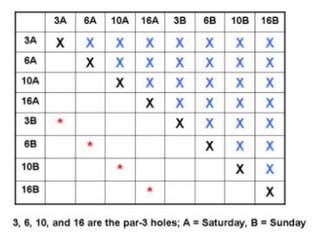I was very pleased to see the A-J article probe the statistical aspects of Mr. Leake's accomplishment, drawing from a set of probability estimates of various hole-in-one phenomena made years earlier by mathematician Francis Scheid for Golf Digest. Scheid's estimates are also shown here, in the yellow-shaded sidebar to a 2005 Golf Digest article (toward the bottom of the page that comes up).
What Leake exhibited is nothing, if not a hot hand, so I had to pursue the topic further. The neatest thing I found was an amazing USA Today page on holes-in-one, which includes links to a compilation of all aces on the PGA tour from 1990 to mid-2006, and to a similar compilation for the LPGA tour (beginning in 1992).
The sidebar accompanying the aforementioned 2005 Golf Digest article stated, among other things, that the odds of an "[a]verage player acing [a] 150-yard hole" were 80,000 to 1, and for a 200-yard hole, 150,000 to 1. Technically, odds are not the same thing as probabilities, but for extremely rare occurrences, the terms converge.
As noted above, the hole that Leake aced twice had a distance of roughly 175 yards from the tee, halfway between the two figures cited in the previous paragraph. Let's use the odds for a 150-yard hole (80,000 to 1). At this point, I'd like to introduce a new twist; some may disagree with this way of addressing the question, but it seems reasonable to me. Even though there are 18 holes in a round of golf, holes-in-one seem to come exclusively (or almost exclusively) on par-3 holes. Texas Tech's Rawls course had four such holes, numbers 3, 6, 10, and 16. In two days, a golfer would thus get to play par-3 holes eight times total.
We can then ask, given a prior probability of 1-in-80,000 (.0000125) of a hole-in-one from a single attempt off the tee, what is the probability of someone acing two (or more) holes in eight opportunities? An online binomial calculator tells us that such probability is .000000004 or 1-in-250 million.
That, however, would be for making a hole-in-one on any two holes out of eight (i.e., the two aces could come from among the four par-3 holes on one day, or from one hole each on the two days and, if the latter, they could be on same hole or different holes).
We have to restrict the situation to scoring the aces on the same hole both days. I've created a chart (below) to illustrate that there are 28 possible ways to ace two holes out of eight, some on the same day, others on different days. The main diagonal is removed (signified by black X's) because, for example, a golfer could not ace Hole No. 3 twice the same day. The 28 blue X's above the diagonal indicate redundancy with the 28 cells below the diagonal. The cells with no X's thus represent the 28 possible ways to ace two holes out of eight. Finally, there are only four cells (indicated by red asterisks) where the golfer would be acing the same hole on back-to-back days. So, among the 28 ways to get two holes-in-one out of eight holes generally, only four ways fit with what happened in Lubbock, and of course 4/28 = 1/7.

We thus multiply our prior value of 1-in-250 million by 1/7, yielding 1 in 1.75 billion. That's my best guess!








